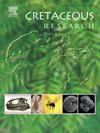Mono– to pauci-specific communities in the Upper Cretaceous of Wadi Qena, Egypt: The combined effect of food and oxygen deficiency
IF 1.7
3区 地球科学
Q1 GEOLOGY
引用次数: 0
Abstract
Understanding the dynamics of ancient marine systems is vital for assessing biodiversity changes in modern ecosystems. This study examines the paleoenvironments of the Upper Cretaceous deposits in the Wadi Qena region (Eastern Desert, Egypt), integrating lithofacies, biofacies, and taphofacies. Based on quantitative analyses of two sections, Wadi Hawashiya and Gabel Qreiya, four firm-bottom and two soft-bottom macrobenthic associations were identified. In Wadi Hawashiya, the Nicaisolopha tissoti association thrived in a shallow, moderate-energy inner ramp lagoonal environment of the Coniacian–Santonian, transitioning to high-energy shoals (calcareous quartz arenite). Two monospecific associations, Pycnodonte (Ph.) vesicularis and Gyrosoria gracilis, along with one pauci-specific Porospherae globularis association, were found in the Campanian–Maastrichtian. These associations indicate a shift to a deeper, outer low-energy ramp environment with a firm substrate and dysoxic, oligotrophic conditions. In Gabel Qreiya, the lower Campanian reflects low-energy tidal flats, while the upper Campanian–lower Maastrichtian contains the Pycnodonte (Ph.) vesicularis association, which lived in a low-energy, firm-bottom inner ramp lagoon. The upper Maastrichtian is dominated by the Lyropecten (A.) acutiplicatus association, which inhabited a deeper outer ramp environment with soft substrates and dysoxic, eutrophic conditions. Overall, the Coniacian–Santonian is marked by higher diversity, while the Campanian–Maastrichtian is characterized by reduced diversity and a dominance of suspension feeders. This shift is interpreted as the result of a combined effect of oxygen deficiency and food shortage, likely caused by a sudden deepening from inner ramp lagoons to outer ramp settings, alongside with declining trophic resources, and oxygen levels.
埃及Wadi Qena上白垩纪的单一到缺乏特异性群落:食物和氧气缺乏的综合影响
了解古代海洋系统的动态对于评估现代生态系统的生物多样性变化至关重要。本文综合研究了埃及东部沙漠Wadi Qena地区上白垩统沉积的岩相、生物相和岩相的古环境。通过对Wadi Hawashiya和Gabel Qreiya两个断面的定量分析,确定了4个硬底和2个软底大型底栖动物群落。在Wadi Hawashiya, Nicaisolopha tissoti组合在coniian - sanantonian的浅层、中等能量的内斜坡泻湖环境中繁盛,过渡到高能浅滩(钙质石英砂岩)。在Campanian-Maastrichtian中发现了2个单特异性组合,Pycnodonte (Ph.) vesicularis和Gyrosoria gracilis,以及1个pauci-specific Porospherae globlaris组合。这些关联表明向更深的,外部低能量斜坡环境的转变,具有坚固的底物和厌氧,少营养条件。在Gabel Qreiya,下坎帕尼亚区反映低能潮滩,而上坎帕尼亚-下马斯垂克区则包含Pycnodonte (Ph.) vesicularis组合,它们生活在低能、坚固底的内斜坡泻湖中。上马斯特里赫特区以Lyropecten (a .) acutiplicatus群落为主,生活在较深的外斜坡环境中,基质较软,富营养化条件差。总体而言,coniian - santonian物种多样性较高,而Campanian-Maastrichtian物种多样性较低,以悬浮食饵为主。这种转变被解释为缺氧和食物短缺的综合影响的结果,可能是由于从内部斜坡泻湖突然加深到外部斜坡环境,以及营养资源和氧气水平下降造成的。
本文章由计算机程序翻译,如有差异,请以英文原文为准。
求助全文
约1分钟内获得全文
求助全文
来源期刊

Cretaceous Research
地学-地质学
CiteScore
4.10
自引率
19.00%
发文量
235
审稿时长
12 weeks
期刊介绍:
Cretaceous Research provides a forum for the rapid publication of research on all aspects of the Cretaceous Period, including its boundaries with the Jurassic and Palaeogene. Authoritative papers reporting detailed investigations of Cretaceous stratigraphy and palaeontology, studies of regional geology, and reviews of recently published books are complemented by short communications of significant new findings.
Papers submitted to Cretaceous Research should place the research in a broad context, with emphasis placed towards our better understanding of the Cretaceous, that are therefore of interest to the diverse, international readership of the journal. Full length papers that focus solely on a local theme or area will not be accepted for publication; authors of short communications are encouraged to discuss how their findings are of relevance to the Cretaceous on a broad scale.
Research Areas include:
• Regional geology
• Stratigraphy and palaeontology
• Palaeobiology
• Palaeobiogeography
• Palaeoceanography
• Palaeoclimatology
• Evolutionary Palaeoecology
• Geochronology
• Global events.
 求助内容:
求助内容: 应助结果提醒方式:
应助结果提醒方式:


